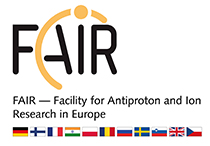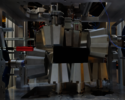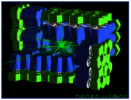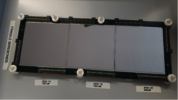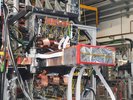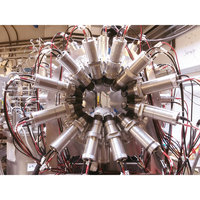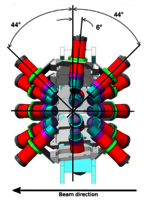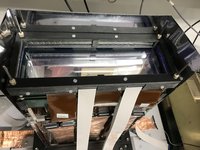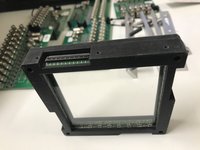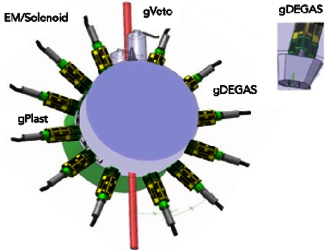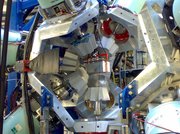DESPEC - DEcay SPECtroscopy
In the DESPEC (DEcay SPECtroscopy) experiment, the radioactive ions are slowed down to come to rest in a stack of highly segmented Silicon-based, implantation and decay detector system (AIDA). This system will be surrounded by a compact high resolution Germanium array, neutron detectors, fast BaF2 detectors and/or a total absorption gamma-ray spectrometer. A magnet for isomeric moment measurements is an additional option. Here, decay studies of dripline nuclei will be the core interest, in particular towards the neutron-rich r-process lines. It will also be possible to combine HISPEC and DESPEC for recoil decay studies, with DESPEC detectors being placed at the end of the magnetic spectrometer.
Instrumentation:
DESPEC Germanium Array Spectrometer (DEGAS)
The DESPEC Germanium Array Spectrometer (DEGAS) is a high-purity germanium gamma-ray detector array for high-resolution spectroscopy of electromagnetic decays from exotic nuclear species. It is a key instrument of the DESPEC experiment at FAIR. At DESPEC rare isotopes produced by the Super-FRS will be stopped in an active implanter (AIDA) surrounded by DEGAS measuring gamma rays rays following α, β, proton, neutron and isomeric decays. The main objectives of DEGAS are:
- the efficient detection of gamma rays in an energy range from 50 keV to 5 MeV emitted from nuclei throughout the full Super-FRS focal plane of 24x8 cm2
- the discrimination of intense background radiation.
To overcome the prompt radiation flash associated with the implantation process, a high detector granularity and fast saturation recovery are required. To detect gamma rays from rare isomers with long lifetimes, proper shielding and identification of background radiation is essential. DEGAS builds on the vast experience obtained with the VEGA and RISING projects at the FRS at GSI. The construction of DEGAS will proceed in three phases. For phase I it is planned to re-use EUROBALL Cluster detectors previously employed at GSI in the RISING stopped-beam campaign. For optimal solid-angle coverage, detector units will comprise three crystals in a common cryostat. Shielding will be based on the EUROBALL “back-catcher” veto scintillation detectors. In phase II, AGATA-type gamma-ray tracking detectors are planned to replace the most background-affected EUROBALL detectors. Contrary to the conventional EUROBALL coaxial Ge detectors, tracking detectors enable efficient detection and rejection of both particle and gamma-ray background. The third phase is planned to include the results of long-term developments of highly-segmented planar Ge detectors for the ultimate “imaging” array.
AIDA - Advanced Implantation Detector Array
The Advanced Implantation Detector Array (AIDA)
AIDA is the core implantation detector for the DESPEC experiment, capable of detecting both stopped ions and subsequent charged particle decay products (such as beta decay, proton decay and alpha decay). The detectors themselves are highly-segmented double-sided silicon strip detectors (DSSDs) with a strip pitch of 0.56 mm. The detectors are available in two configurations: a narrow (8x8 cm2, 128x128 pixel) detector allowing close-packed surrounding detectors, and a wide (24x8 cm2, 386x128 pixel) detector allowing coverage of the full FRS and Super-FRS focal planes. The detectors are arranged in a stack of typically 2-3 detectors, allowing a cocktail of various Z beams to be implanted.
The detectors connect to bespoke electronics modules, situated close to the silicon dectors to minimise noise pickup. The front-end electronics (FEEs) fully process the raw detector signal for 64 channels and handle the data acqusition using a combination of ASIC and FPGA technologies. An autonomous gain-switching ASIC is used to handle the high dynamic range required to detect both ion and decay products, switching between a high gain for low-energy particles and a low gain for high-energy particles, without any external signals. Data is "triggerless", using the total data readout (TDR) technique providing very low deadtime and allowing high rates of up to 500 kHz per 64 channels. Energy resolution is 50 keV FWHM and timing resolution up to 10 ns (2 us for low noise analogue readout). The individual FEEs (4 per narrow DSSD, 8 per wide DSSD) are synchronised using the White Rabbit timing system and otherwise run independently.
Resources:
https://www2.ph.ed.ac.uk/~td/AIDA/
FATIMA - FAst TIMing Array
FATIMA (FAst TIMing Array) is a high-efficiency array of LaBr3(Ce) detectors designed for measurements at DESPEC. The ultra-fast timing method using fast response scintillation detectors is a well-established method to measure level lifetimes in the range from a few picoseconds to several nanoseconds. Its main application is for the exotic nuclei populated in beta-decay and via de-excitation of microsecond isomers at DESPEC. High precision results can be obtained at the level of intensity as low as 1-5 particles/s for exotic nuclei. The complete FATIMA will consist of 48 detectors arranged around the DESPEC implantation point. A hybrid gamma-ray array comprising 36 FATIMA modules in conjunction with HPGe cluster detectors was used in DEPEC Phase-0 experiments in 2020-2021. An upgraded configuration, compatible with the wide 24x8cm2 AIDA implantation station and with improved gamma-ray efficiency, will be used in Phase-0 in 2024.
Resources:
βPlast fast plastic scintillators
The βPlastic detectors comprise a quadrilateral 3-mm thick sheet of scintillating plastic material (type BC-404) coupled to 3x3-mm2 silicon photomultipliers (SiPMs) along the four sides. Typically, βPlastic detectors are mounted both upstream and downstream of the AIDA DSSDs within a light-tight 'snout'. The excellent timing properties of the βPlastic detectors allow high-precision time information for decays originating from implanted ions inside AIDA to be measured. The βPlastic detectors may also be used as implantation devices themselves, and can provide a high-efficiency veto of unwanted light ions that may punch through AIDA. The SiPMs are secured to the scintillating material via an optical coupling pad that is kept in place using a custom-fitted housing. The SiPM signals are read out by custom-made, shielded flat cables and then pass through “booster boards”, which provide an amplification factor. The amplified signals are then accessible by Lemo outputs and fed into FPGA-based TAMEX4 cards with TwinPeaks front-ends, developed inhouse by the Experimental Electronics Department at GSI.
gSPEC at GSI/FAIR
Nuclear moments with gSPEC at GSI/FAIR
In the strongly correlated nucleus, especially around doubly-magic numbers, the unpaired nucleon, or nucleons, governs its structure. Sensitive to the nature of these single-particle excitations, nuclear moments and g-factor investigations of isomeric states in regions close to doubly-magic 208Pb,100,132Sn, 78Ni are the primary goals of the future gSPEC measurements that may further span all over the nuclear chart. A variety of nuclear phenomena are accessed by these investigations, which are sensitive to the intrinsic features of the M1 operator, to collective properties and to the deformation of excited states in exotic nuclei.
Studying g-factors during the g-RISING campaign at GSI [1,2] showed that aligned isomeric beams might be maintained in flight and used for nuclear moment measurements. This essential step makes the future campaigns at GSI-FAIR unique for heavy-ion physics, together with highly-improved beam quality, intensity, and access to very exotic species [3]. The dedicated experimental approach to nuclear moments is based on well-identified isomeric species, implanted in a magnetic field environment. This is provided by a custom superconducting electromagnetic device, reaching fields up to 2 T and showing excellent homogeneity (see Fig. 1). The tracking is assured by a scintillation detector (gPlast) covering the implantation region (with excellent time and position resolutions). The γ-ray detection foresees several DEGAS (gSPEC-0) and re-formatted gDEGAS detectors [4] in linear arrangement (gSPEC-1) with optimized timing properties.
Resources:
[1] G. Neyens et al., Act. Phys. Pol. B 38, 1237 (2007).
[2] H.J. Wollersheim et al., Nucl. Instr. Meth. A 537, 637 (2005).
[4] https://g-wiki.gsi.de/SWiki/DEGAS
gSPEC collaborating institutions
IJCLab, Université Paris-Saclay, IN2P3/CNRS, France
IPHC, Université de Strasbourg, IN2P3/CNRS, France
GSI/FAIR, Darmstadt, Germany
ANU, Canberra, Australia
U. Athens, Athens, Greece
MONSTER - MOdular Neutron SpectromeTER
MONSTER - MOdular Neutron SpectromeTER
